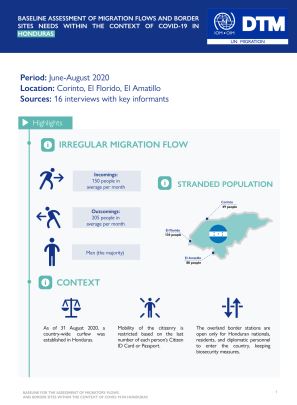-
Countries
-
Data and Analysis
-
Special Focus
-
Crisis Responses
Honduras-Baseline assessment of migration flows and border sites needs within the context of COVID-19 report #1 (June-August, 2020)

Contacto
Melanie Gomez magomez@iom.int
Idioma
English
Ubicación
Honduras
Fecha de instantánea
Jun 01 2020
Aug 31 2020
Actividad
- Flow Monitoring
- Mobility Tracking
- Baseline Assessment
- Event Tracking
Due to the alarming levels of propagation and the serious nature of the COVID-19 virus, on 11 March 2020 the OMS declared a State of Pandemic. On the same date Honduras confirmed its first two cases of COVID-19. During the first weeks of March the Government of Honduras began taking measures to control propagation of the virus within the country. The first death due to COVID-19 was confirmed on 25 March.
In order to prevent COVID-19 contagions, Honduras established various guidelines as part of its response to the emergency. In terms of mobility, a country-wide curfew was established, as well as Red Alert for the eighteen Departments that comprise Honduran territory. Mobility of the citizenry was restricted based on the last number of each person’s Citizen ID Card or Passport. The country’s international airports, seaports, and overland border crossings were also closed. All of said measures have been adjusted depending on the current contagion status at the time.
As of 31 August 2020, Honduras had reopened its domestic and international airports, maintaining biosecurity measures while allowing persons to enter and exit the country. According to the National Migration Institute (INM), however, the overland border stations were open only for Honduran nationals, residents, and diplomatic personnel to enter the country. Foreigners are allowed to leave Honduras provided they have an entry and/or transit permit from the destination country. Freight haulers are also allowed to enter and exit the country. The seaports are open only for cargo ships.
In light of the situation caused by the COVID-19 Pandemic, the IOM seeks to determine: the impact of same on mobility in regular and irregular migratory flows; the needs of migrants; and the measures taken to prevent propagation of the virus along the borders of El Salvador. This is the reason this Study was carried out, in order to generate baselines for comprehending existing needs at the official and unofficial points of entry, in order to provide input to orient actions to be taken by protection organizations at the inter-agency level, local governments, cross-border panels, and IOM field personnel.
